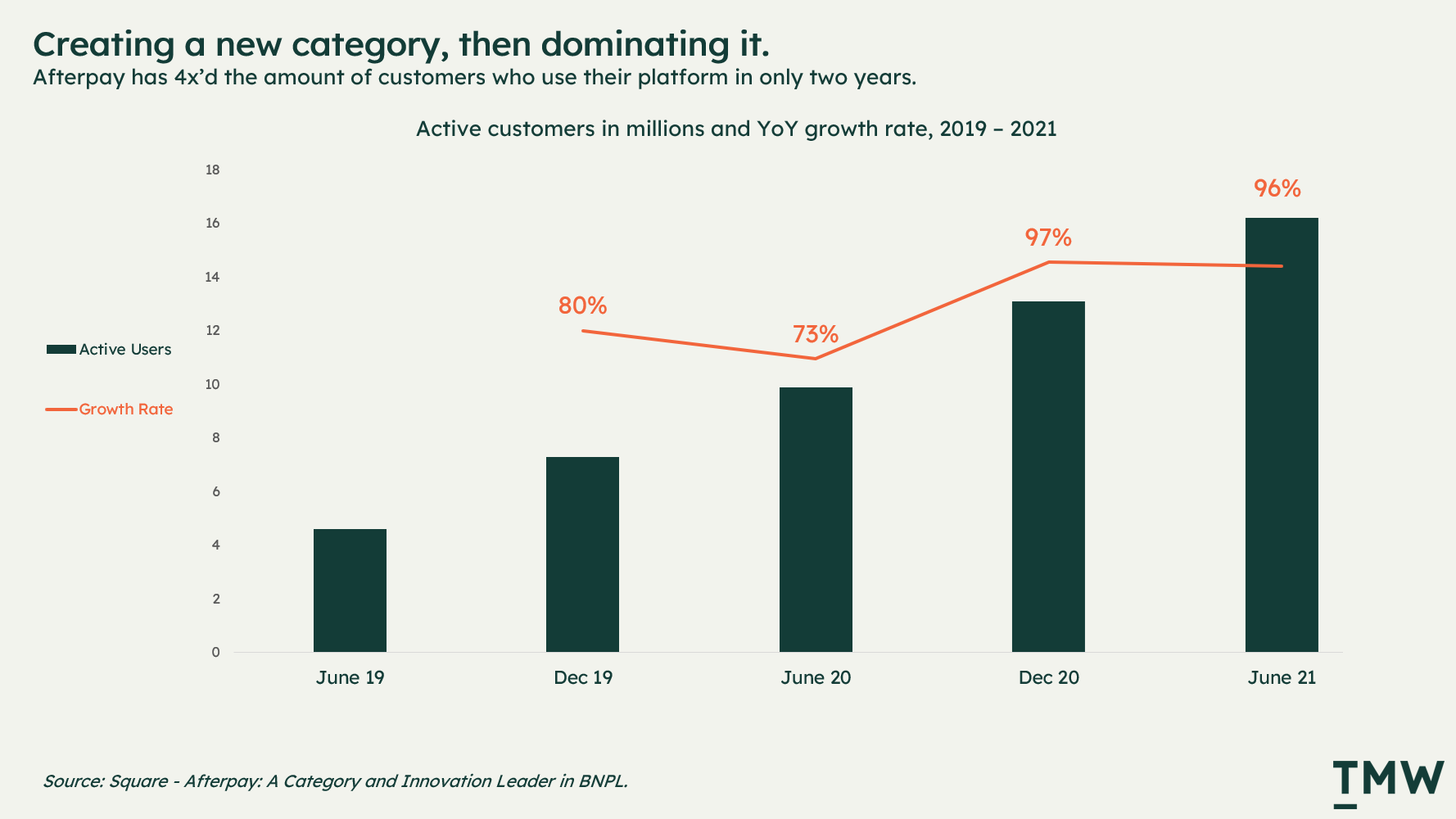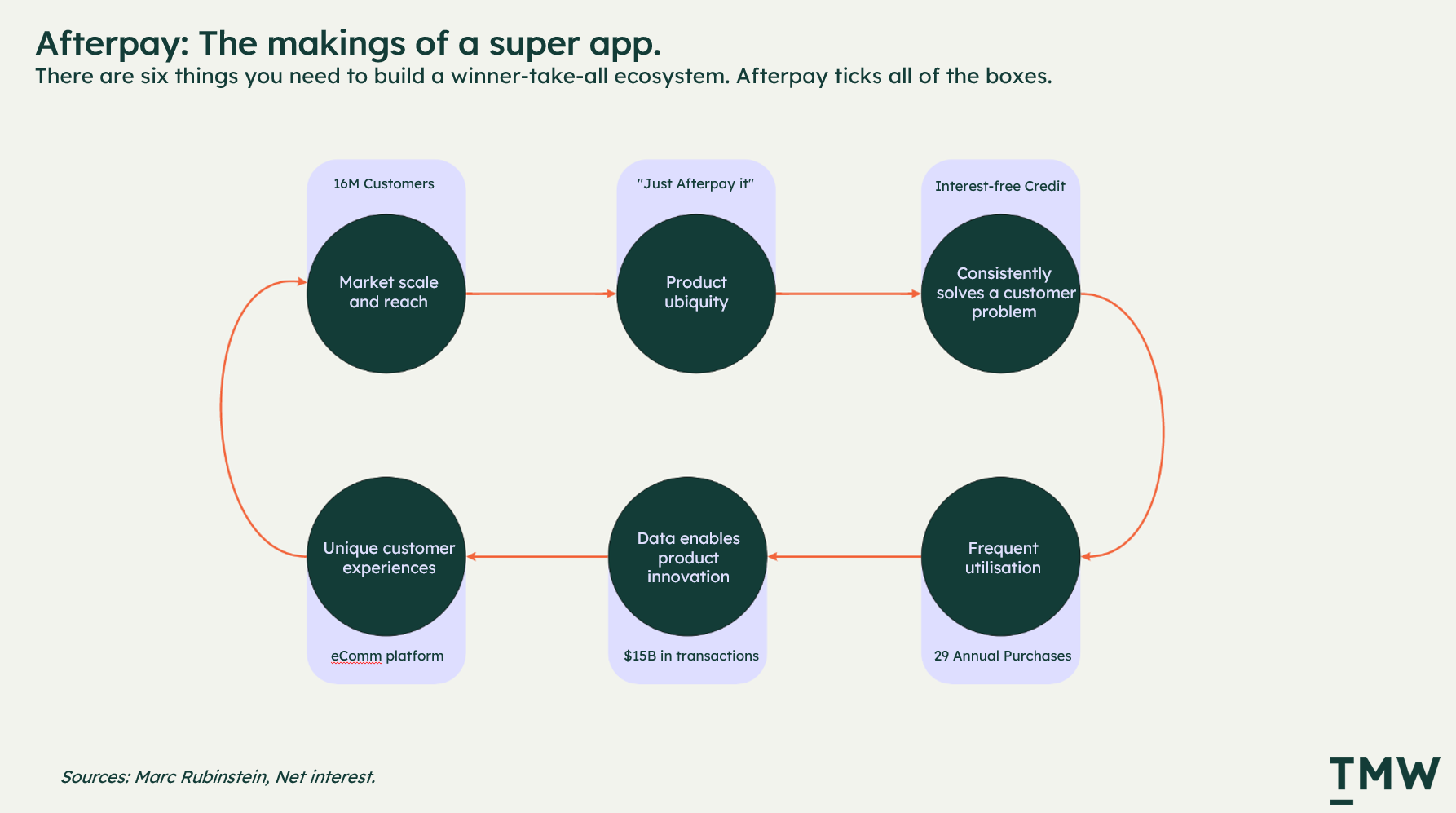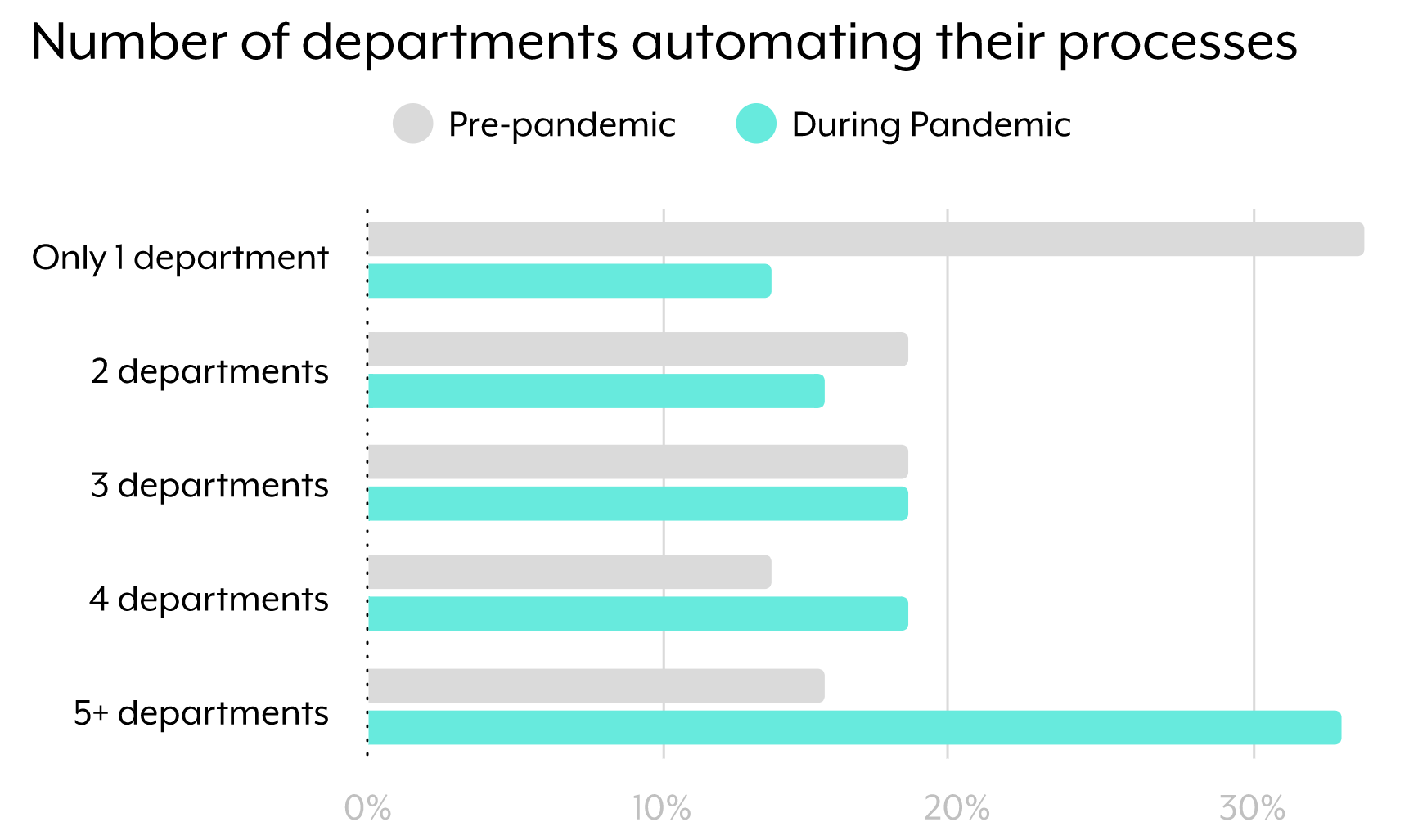TMW #051 | Square + Afterpay, Metaverse! Metaverse! Metaverse? The state of work automation.
Welcome to The Martech Weekly, where every week I review some of the most interesting ideas, research, and latest news. I try to look to where the industry is going and make sense of it all.
👋 Why you should sign up
There are two versions of TMW, the full version for subscribers and a 50% version that's for everyone. You are reading the 50% version. Sign up to get the full version delivered every Sunday for this and every TMW. Learn more here.
👋 Hello and welcome to new subscribers from Russia, The United States, Australia, Romania, Spain, Mexico, France, Poland, Costa Rica, Finland, Vietnam, The United Kingdom, and India!
It’s wonderful to be back after a two-week hiatus. Over this time I’ve learned two things:
- I’ve genuinely missed writing this newsletter, and connecting with you all over what matters in marketing tech. More than I ever realized. Once you find something that endlessly fascinates you, work becomes play.
- I’ve had more subscribers from more places in the world than ever before. This is during a period with no new content, or social media activity. Don’t listen to the gurus who tell you to post stuff every day. Build a brand and stand for something. People will pay attention.
I’ve got some big announcements coming up in the next few weeks as we celebrate the 52nd newsletter and a year since I launched TMW formally.
Before we get into things, a new episode of MSoM is up. I interview Jessica Box, the head of growth for Linktree, the link in bio startup with more than 15 million users. We talk about the technologies that are helping to bring more creators online, “everything as a service” and the death of the website. Listen.
This week in TMW #051:
💳 Square + Afterpay: The dawn of the payment super apps is here.
📺 Metaverse! Metaverse! Metaverse?: Why is everyone in tech talking about this? Does it even matter?
⚙ The state of work automation: There’s more automation across large, complex teams than ever before.
Everything else: The Taliban’s leverage over media and tech, Apple’s privacy backflip, Airtable, content curation, executing at Facebook, Salesforce TV, and much, much more.
✍ Commentary
Afterpay + Square = The dawn of payment super apps. Afterpay is not a payments company and neither is Square. I’m sorry but it’s true. These companies represent the emergence of the integrated payments platform, connecting merchants to customers and customers to payments.
In recent weeks it was announced that Square will be acquiring the Australian Afterpay for US$33 billion, triggering one of the largest financial tech deals in 2021 and endless speculations from the financial sector.
But let’s be clear for a minute: The goal of this US$33 billion dollar acquisition is to take customers from the digital advertising, banking, and credit cards sectors all at once. In a move that companies like Paypal and Klarna are following, there’s a clear consumer appetite and strong merchant rationale for why payment apps should become platforms in their own right. Here’s why: The current market penetration for the buy-now-pay-later industry globally is around 2%, and Square’s CFO forecasts the market opportunity at $10 trillion over coming years. BNPL solves problems that credit cards, banks, and loans don’t - marketing.
All of this was pioneered by Afterpay, and the story of their growth is phenomenal. Back in 2016, they projected A$677 million in merchant sales by 2018. Instead, they did A$2.2 billion. By June 2021 they 10x’d that number - A$21.1 billion. Afterpay’s consumer base is still increasing by 90% year on year. In Square’s official business evaluation report, the Afterpay name is frequently put against “omnichannel”. And the reasons for this are clear - Afterpay is sending more than 1 million customers to merchants every day. They do this through their marketplace, offering exclusive deals, and locking in customers into their payments ecosystems. A staggering 29 purchases are made by the average customer who’s been using Afterpay for 4 or more years. People love it, that’s a fact.

So why should we treat the Afterpay acquisition as an indicator of future payment super apps? Square’s problem has mostly been connecting the two sides of the market. Tools for merchants (marketing, sales, payments) and consumers (lending, payments, CX) are separated into Square’s core app and the Cash App. Afterpay is one of the first companies to bring both sides together with an attractive value proposition.
Let’s look at it from the customer’s perspective. I use Afterpay to buy mostly clothes and groceries because it’s an easier way to manage my money without the risk of interest rates. When I log into the Afterpay app, I can browse deals from retailers who offer the service and purchase with little to no friction. Quite similar to Amazon’s one-click payments, knowing that everything is synced to my debit card. It also means that I don’t have to navigate nebulous retailer shipping forms or deal with their customer service people (most of the time). It’s simpler, easier and I get to save money - why not?
Merchants have to make more sacrifices, but in the retail industry, the math makes sense most of the time. One example is General Pants seeing 50% of their conversions ceded to Afterpay in the first week of going live with the tool. With most merchants seeing a significant increase in conversion should tell you that Afterpay is a marketing and conversion tool. The trade-offs are clear, however. Afterpay is an existential platform risk, once you start outsourcing your payments experience, and the discoverability of products, then those things are out of your control. When Afterpay starts raising the rents what happens next? Ecommerce businesses already run on paper-thin margins anyway, and Afterpay’s suggestion that digital performance is better with them than without them rings true.
This is why Square wants us to believe that Afterpay is the answer to bring both sides together. The plan is to natively integrate Afterpay into the apps that people already use within Square’s offering. The value proposition then becomes clear - whenever you shop, wherever you shop you know you can trust out services to get it done quickly and easily. This is the same deal with Merchants, make more money and let us take care of the hard stuff. However, to become a super app Tom Noyes gives a helpful guide of six things a product will need:

There’s a reason why Afterpay is worth $33 billion to Square. BNPL is an alternative to the credit card for the next generation of shoppers. But what Afterpay did that Mastercard, Visa couldn’t do was become a platform for discovery, and a way to funnel new and high-value shoppers into merchant’s stores, all the while making eCommerce brands pick up the bill. The acquisition is the next step into a future where payment technologies become marketing technologies that get to set the tone for how shoppers want to pay. Links: Press release. Afterpay transaction overview. After Afterpay.BNPL wars. Noyes Payments Blog: Paypal and super apps. CBI: State of BNP
Metaverse! Metaverse! Metaverse? It seems that right now everyone in tech is talking about a single idea that’s shrouded in mystery, highly philosophical, and is used in conjunction with world-changing pronouncements: The Metaverse. In the past month alone we’ve had Zuckerberg come out and say “Facebook is a Metaverse Company” along with Microsoft chief Satya Nadella offer up a suite of Azure products as a strategy to deliver an “Enterprise Metaverse.” Some of the tech industry’s titans are betting big on something only a few know about, let alone define properly.
So what is the Metaverse? And can we adequately call it a marketing technology? Matthew Ball offers seven characteristics of what defines the Metaverse, in which all really boil down to a few key things. It involves a digital environment (like Roblox or Minecraft), is synchronous (you can do things with other people in it), and has the ability to do commerce inside of it, (buy, sell, and exchange). So you could say that almost every multi-player game is its own Metaverse, even games stretching back as far as the early ’90s like Runescape. Yet what Zuck and Nadella are working towards is something slightly different, it’s the application of game dynamics into broader aspects of internet society. A few hints of this came out last week with the announcement of workplace horizons, Facebook’s VR-powered meeting room, complete with avatars of your work colleagues. The reception hasn’t been great, but you can see where it’s heading.
I know someone who spends a full-time workweek in front of two monitors and a racing-themed swivel chair. What are they doing? Playing massive online multiplayer games. Sadly it’s a drain of resources and attention. The future that’s painted in broad strokes by tech executives leans into this picture, where the majority of our time is spent inside someone else’s digital creations. Sure, we already spend many hours on Zoom or Microsoft Teams but judging from how many complaints I see daily on Twitter, it’s not a good thing.
The Metaverse is a concept that relies heavily on many people wanting to don VR headsets and spend even more time online than they already do, replicating all of the social “features” of working in a real office or going to a real party with real people. Facebook wants the Metaverse to become something, because of the VR opportunity and Microsoft wants to dominate software for a remote working world. But none of this has anything to do with the experience of the user. Unless you’re a 16-year-old kid buying avatar skins on Fortnite, you probably would rather go for a nice walk with a friend than go for a virtual crusade with internet randoms.
The opportunities presented to us in the Metaverse for marketing and customer experience serve only a small cadre of companies like gaming, entertainment, fashion, and digital goods. I struggle to see any future where health insurance or finance will be leaning into virtual worlds, but time will tell. However, the innovations of the Metaverse should be embraced as I wrote back in #040 on the incredible power of Roblox. The next generation is really into these ideas and is thriving in ways we’re yet to fully appreciate.
New ideas like the Metaverse remind me of the staggering rise and fall of Clubhouse, a pandemic app that brought temporary relief to our need to connect with others. Doing a VR call where I’m conversing with avatars of my team seems fun, but there’s very little there to keep busy workers going to the extra effort. Yet, as Dror Poleg suggests, for many people their digital experience offers far more opportunity and vibrancy than their physical one, perhaps the Metaverse will offer customers something “immeasurably richer and more fulfilling than most of the physical and social environment around them in the quote-unquote real world.” Links: Stratechery: Metaverses. Dror Poleg: Physical vs Digital, Mark Zuckerberg’s Metaverse. Microsoft and the Metaverse. Hal Crawford: Reporting from the Metaverse.Matthew Ball’s Metaverse Primer.
📈Chart Of The Week
Enterprise automation. It’s growing. A recent survey from Workato analyses the before and after of enterprise work automation. The results are not surprising, more companies are investing in automation than ever before. But what is interesting is the cross-functional areas where this growth is happening. The biggest gains in automation investment have been in customer support case resolution and managing orders and fulfillment, along with IT helpdesk interactions. Yet the biggest overall gains are happening in companies where more than five teams are involved in it. Larger, more diverse teams seem to be relying on automation to improve how they work together. Link

📰 Latest Developments
Apple’s privacy backflip. Apple has announced new features targeting child sexual abuse material (CSAM), mostly focused on applying ML over iCloud photos on devices to spot occurrences of the material and automatically report it to authorities. This is quite the thorny issue as Apple has positioned the iPhone as their champion of privacy, yet this move contradicts that value proposition. Stopping CSAM is important, but Apple’s approach seems to be at odds with its value proposition. Link Also see Max Hodak’s deep dive.
Adobe acquires Frame.io. Remember last year when Adobe acquired Workfront? This one makes more sense in the context of Adobe’s broader push into marketing operations. Frame.io is a cloud-based video collaboration platform. Adobe doesn’t offer a solution for collaboration in this way, but for their products, it makes alot of sense. Design, data, and campaigns all need collaboration. Link
Australia - The next tech capital? This week Tim Cook said that he’s seeing innovation coming from the island nation that blows his mind, and there’s a growing chorus of people saying that Australia has the right conditions to become the next big tech powerhouse. So much so that there’s now a “tech council” claiming that the tech sector has contributed $167 billion of GDP last year to the economy. Link. Tech Council.
📚 Reading
Airtable teardown. An interesting read on the place of the database/productivity/automation platform. The positioning of their products to enterprise businesses as a no-code app builder is especially interesting. Link
The Taliban’s media and tech strategy. Two outstanding pieces analyze the role of the Taliban’s social media strategy in how they were able to swiftly take over Afghanistan because of it. Years went into their communications strategy to slowly erode trust in government and win over more converts. Good or evil, everyone has the tools now to run complex campaigns like any marketer. Rest of world, Bloomberg.
Bad data and ad fraud, a study. An interesting study from BDEX outlines the sheer scale of ad fraud due to bad or misleading customer identifiers. Their research uncovered more than 25% of invalid device identifiers, from a data set of one billion identities Link
🔢 Data & Insights
Salesforce’s massive state of marketing survey. It's big. Link
Mulesoft: People are still frustrated with IT and are integrating things themselves. Link
Big list of Martech startup funding news: 48+ investments and acquisitions this year and counting. Link
💡 Ideas
Curator as the next creator. Could you build a business model around your good taste? In alot of ways, this is what influencer marketing is. The argument in this piece is that the saturation of content online needs trusted people to curate it for others. Maybe it’s the reason you’re reading this newsletter? Link
Executing at Facebook. No standups, no tickets, no sprints. PMs focus on vision and strategy and engineers manage their own work. Sounds like a dream come true right? Link
eCommerce and the final mile. How an eCommerce brand does logistics determines if they are going to be profitable. Fulfillment is one of the most critical things in the customer’s experience to get right, but it’s costly and complicated, and this is especially true for the last mile. Link
✨ Weird and Wonderful
The internet incentives of media. This piece is an incredible rant, but most of it rings true. The incentives of ad-driven business models and social media have transformed once-great publishers into click farms. The author Walter Kirn suggests that what we read in the news today “consists of its decomposed remains in a news-shaped coffin.” Link
Salesforce TV? I can’t wait to kick my shoes off after a long hard week to binge on some... Salesforce + ??? Link
The reason why consultants speak in gibberish. Velocity… Socialize…. Alignment…. All strange words that come out of the consultant’s mouth. Maybe there’s a reason why we use so much jargon? Link
Stay Curious,
Make sense of marketing technology.
Sign up now to get the full version of TMW delivered to your inbox every Sunday afternoon plus an invite to the slack community.
Want to share something interesting or be featured in The Martech Weekly? Drop me a line at juan@themartechweekly.com.
